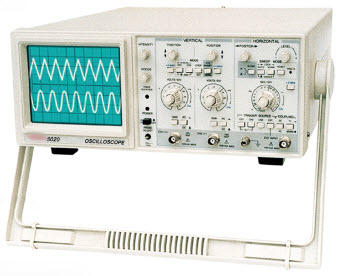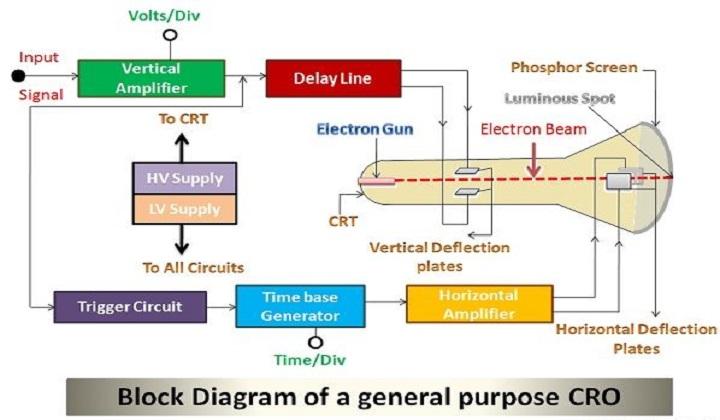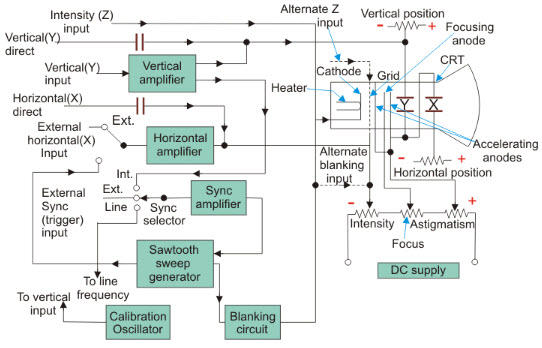Cathode Ray Oscilloscope is an instrument used in electrical current science and electronics. This instrument is useful for measuring and analyzing electrical currents, such as analyzing curves, frequencies, and phases of signals. This equipment is used in teaching and research in various fields, such as electronic engineering, physics, and other science fields. Using cathode ray oscilloscope, we can analyze the initial and final states of various signals, giving us detailed information and helping us understand electronic capabilities.
What is cathode ray oscilloscope (CRO)?
Cathode ray oscilloscope is an electronic testing instrument, it is used to obtain the waveform when given various input signals. Earlier it was called oscillograph. An oscilloscope observes changes in electrical signals over time, thus voltage and time describe a shape and are continuously graphed according to a scale. By looking at the waveform, we can analyze some properties like amplitude, frequency, rise time, distortion, time interval and etc.

Block diagram of cathode ray oscilloscope (CRO)
The functionality of an oscilloscope can be understood more easily with the help of its block diagram. To understand a block diagram more clearly we need to focus on its major parts. Let us discuss what are the parts that make up a device that can generate waves.

Structure of cathode ray oscilloscope
The composition of the cathode ray includes the following components:
- Cathode Ray Tube
- electronic gun
- deflecting plate
- Fluorescent screen for CRT
- glass envelope
Cathode Ray Tube
CRO is a vacuum tube and the basic capability of this device is to convert signals from electrical to visual. This cylinder includes the electron gun as well as electrostatic safety plates. The primary purpose of this electron gun is to produce a focused, high-frequency electronic beam. The upward redirection plate will direct the beam up and down while the flat beam will direct the electrons to the right or left.
electronic gun
The main function of the electron gun is to emit electrons and convert them into a beam. This gun mainly consists of a heater, a grid, cathode and anode for accelerating, pre-accelerating and focusing. At the end of the cathode, strontium and barium layers are deposited to achieve high electron emission of electrons at moderate temperatures, layers of barium, and strontium are deposited at the end of the cathode.
Deflecting Plates
Once the electron beam exits the electron gun it will pass through two sets of beam deflector plates. This set will produce vertical deflection of Y plate otherwise known as vertical deflection plate. The second set of plates is used for horizontal deflection otherwise known as horizontal deflection of X plate.
CRT fluorescent screen
In a CRT, the front part is known as the faceplate, for a CRT screen, it is flat and has a size of about 100mm×100mm. CRT screens are bent somewhat for larger displays and faceplates can be manufactured by pressing molten glass into a shape and then heating it. When an electron beam strikes a phosphor crystal, the energy level can be increased and thus light is produced during phosphorus crystallization, hence this phenomenon is known as fluorescence.
glass envelope
This is an extremely vacuum conical form of construction. The inside parts of the CRT between the neck and the display are covered with AquaDag. It is a conductive material that acts as a high-voltage electrode. The surface of the coating is electrically coupled towards the accelerating anode to help center the electrons.
Working Principle of Cathode Ray Oscilloscope (CRO)
A CRO (Cathode Ray Oscilloscope) works by using a high-speed electron beam that is deflected by an electric or magnetic field to produce a visual display of an electrical signal. When an electrical signal is applied to two deflection plates to generate an electric field perpendicular to each other. The electron beam is deflected by these fields, causing it to strike the phosphorescent screen, producing an illuminated spot. The position of the spot on the screen indicates the magnitude and waveform of the electrical signal. By measuring the position of the spot the frequency, amplitude, and waveform of the signal can be determined.

Controller of Cathode Ray Oscilloscope (CRO)
The basic controls of a CRO mainly include position, illumination, focus, astigmatism, blanking, and calibration.
position
In an oscilloscope, the position control knob is mainly used for position control of the sharp spot from left to right. By controlling the knob, one can easily control the position from left to right.
Illumination
The illumination of the beam depends mainly on the intensity of the electron. The control grids are responsible for the electron intensity inside the electron beam. So, the grid voltage can be controlled by adjusting the illumination of the electron beam.
focus
Focus control can be achieved by regulating the voltage applied toward the center anode of the CRO. The middle and other anodes in its region can form electrostatic lenses. Therefore, the main length of the lens can be changed by controlling the voltage at the center anode.
astigmatism
In CRO, this is an additional focusing control and is analogous to the astigmatism inside the optical lens. A beam focused in the middle of the monitor will defocus at the edges of the screen because the electron path lengths are different for the center and edges.
blanking circuit
The time base generator in the oscilloscope generated the blanking voltage.
calibration circuit
An oscillator is essential for the purpose of calibration within an oscilloscope. However, the oscillator used must produce a square wave for a preset voltage.
Applications of Cathode Ray Oscilloscope (CRO)
- CRO is used in radio stations to observe the characteristics of sending and receiving signals.
- Voltage, current, frequency, inductance, admittance, resistance, and power factor are all measured with a cathode ray oscilloscope.
- Additionally, the properties of AM and FM circuits are examined using this instrument.
- This equipment is used to regulate analog signals as well as monitor and analyze signal characteristics and characteristics.
- Through the resonance circuit, CRO is used to observe the form, bandwidth, etc. of the signal.
- The cathode ray oscilloscope can examine the shape of the voltage and current waveform, which aids in decision making on a radio station or communications station.
- It is used for research purposes in laboratories.
- CRO is extensively employed in hysteresis loops to trace the BH curve.
- It is possible to trace transistor curves using CRO.
Benefits of CRO
- Cost and timeline
- training requirements
- consistency and quality
- time efficiency
- Expertise and Experience
- problem-solving ability
- hassle free
- Assurance of regulatory compliance
- voltage measurement
- current measurement
- waveform test
- Measurement of phase and frequency
Limitations of Cathode Ray Oscilloscope (CRO)
- These oscilloscopes are expensive compared to other measuring instruments like multimeters.
- Once damaged they are complicated to repair.
- These devices require complete isolation.
- These are larger, heavier and use more power.
- A lot of control terminals that are not so easy to understand at once, but easy to use, digital storage oscilloscope can be used for multiple channel capture and screen and waveform clarity.
Use of CRO
In the laboratory, CRO can be used as
- It can display different types of waves
- It can measure short time intervals
- In voltmeter it can measure the potential difference.
Sharing is caring!
